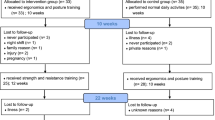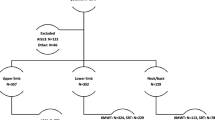Abstract
The Progressive Isoinertial Lifting Evaluation (PILE) and the lifting test of the WorkWell Systems Functional Capacity Evaluation (WWS) are well known as lifting performance tests. The objective of this study was to study whether the PILE and the WWS can be used interchangeably in patients with Chronic Low Back Pain (CLBP) and to explore whether psychosocial variables can explain possible differences. Methods: 53 Patients (32 men and 21 women) with CLBP were tested twice in a counter balanced design. Pearson Correlation Coefficient of r > 0.75 and non-significant differences on two-tailed t tests were considered as good comparability. Results: Pearson Correlation Coefficient was 0.75 (p < 0.01). Lifting performance on the WWS was a mean of 6.0 kg higher compared to the PILE (p < 0.01). The difference between the PILE and the WWS was unrelated to psychological variables. Conclusion: It can be concluded that the PILE and the WWS cannot be used interchangeably. Psychosocial variables cannot explain the differences between both tests.
Similar content being viewed by others
Reference
Hansson E, Hansson T, Jonsson R. Predictors for work ability and disability in men and women with low-back or neck problems. Eur Spine J 2005.
Gross DP, Battie MC. Reliability of safe maximum lifting determinations of a functional capacity evaluation. Phys Ther 2002;82(4):364–71.
Johnson LJ. The kinesiophysical approach matches worker and employer needs. Isernhagen SJ. The comprehensive guide to work injury management. Gaithersburg, MD: Aspen Publishers; 1995. p. 399–409.
Snook SH, Ciriello VM. The design of manual handling tasks: revised tables of maximum acceptable weights and forces. Ergonomics 1991;34(9):1197–213.
Khalil TM, Goldberg ML, Asfour SS, Moty EA, Rosomoff RS, Rosomoff HL. Acceptable maximum effort (AME). A psychophysical measure of strength in back pain patients. Spine 1987;12(4):372–6.
Isernhagen SJ. Work injury, management and prevention. Gaithersburg, Maryland, USA: Aspen publishers, inc; 1988.
Mayer TG, Barnes D, Kishino ND, Nichols G, Gatchel RJ, Mayer H, Mooney V. Progressive isoinertial lifting evaluation. I. A standardized protocol and normative database. Spine 1988;13(9):993–7.
Isernhagen SJ. Functional capacity evaluation: rationale, procedure, utility of the kinesiophysical appproach. J Occup Rehabil 1992;2(3):157–68.
IJmker S, Gerrits EH, Reneman MF. Upper lifting performance of healthy young adults in functional capacity evaluations: a comparison of two protocols. J Occup Rehabil 2003;13(4):297–305.
Geisser ME, Robinson ME, Miller QL, Bade SM. Psychosocial factors and functional capacity evaluation among persons with chronic pain. J Occup Rehabil. 2003;13(4):259–76.
Grotle M, Vollestad NK, Veierod MB, Brox JI. Fear-avoidance beliefs and distress in relation to disability in acute and chronic low back pain. Pain 2004;112(3):343–52.
Vlaeyen JW, Kole-Snijders AM, Boeren RG, van Eek H. Fear of movement/(Re)injury in chronic low back pain and its relation to behavioral performance. Pain 1995;62(3):363–72.
Waddell G, Newton M, Henderson I, Somerville D, Main CJ. A fear-avoidance beliefs questionnaire (FABQ) and the role of fear-avoidance beliefs in chronic low back pain and disability. Pain 1993;52(2):157–68.
Pfingsten M, Leibing E, Harter W, Kroner-Herwig B, Hempel D, Kronshage U, Hildebrandt J. Fear-avoidance behavior and anticipation of pain in patients with chronic low back pain: a randomized controlled study. Pain Med 2001;2(4):259–66.
Lygren H, Dragesund T, Joensen J, Ask T, Moe-Nilssen R. Test-retest reliability of the progressive isoinertial lifting evaluation (PILE). Spine 2005;30(9):1070–4.
Brouwer S, Reneman MF, Dijkstra PU, Groothoff JW, Schellekens JM, Goeken LN. Test-retest reliability of the isernhagen work systems functional capacity evaluation in patients with chronic low back pain. J Occup Rehabil 2003;13(4):207–18.
Crombez G, Vlaeyen JW, Heuts PH, Lysens R. Pain-related fear is more disabling than pain itself: evidence on the role of pain-related fear in chronic back pain disability. Pain 1999;80(1–2):329–39.
Swinkels-Meewisse EJ, Swinkels RA, Verbeek AL, Vlaeyen JW, Oostendorp RA. Psychometric properties of the tampa scale for kinesiophobia and the fear-avoidance beliefs questionnaire in acute low back pain. Man Ther 2003;8(1):29–36.
Arrindel WA, Ettema JHM. Symptom Checklist-90. Handleiding bij een multidimensionele psychopathologie-indicator. Lisse The Netherlands: Swets test publishers; 2003.
Schreurs PJG, van de Willige G, Brosschot JF, Tellegen B, Graus GMS. De Utrechtse Coping lijst: UCL. revised version ed. Utrecht: Swets test publishers; 1993.(Vakgroep klinische psychologie en Gezondheidspsychologie).
Roland M, Fairbank J. The Roland-Morris disability questionnaire and the oswestry disability questionnaire. Spine 2000;25(24):3115–24.
Brouwer S, Kuijer W, Dijkstra PU, Goeken LN, Groothoff JW, Geertzen JH. Reliability and Stability of the roland morris disability questionnaire: intra class correlation and limits of agreement. Disabil Rehabil 2004;26(3):162–5.
Innes E, Straker L. Validity of work-related assessments. Work 1999;13(2):125–52.
Portney LG, Watkins MP. Foundations of clinical research; applications to practice. 2 edn. Upper Saddle River, New Jersey: Prentice-Hall, Inc.; 2000.(vol. 23).
U.S. Department of Labor, The revised handbook for analyzing jobs. 4 edn. JIST Works, inc., Indianapolis; 1991.
Genaidy AM, Asfour SS, Mital A, Tritar M. Psychophysical capacity modeling in frequent manual materials handling activities. Hum Factors 1988;30(3):319–37.
Karwowski W, Shumate C, Yates JW, Pongpatana N. Discriminability of Load Heaviness: Implications for the psychophysical approach to manual lifting. Ergonomics 1992;35(7–8):729–44.
Hodselmans AP, Jaegers SM, Goeken LN. Short-term outcomes of a back school program for chronic low back pain. Arch. Phys Med Rehabil 2001;82(8):1099–105.
Reneman MF, kool J, Oesch P, Geertzen JHB, Battie MC, Gross DP. Material handling performance of patients with chronic low back pain during functional capacity evaluation: a comparison between three countries. accepted Disabil. Rehabil. 2006.
Acknowledgement
The authors are grateful for data supply from the LOBADIS 2 study.
Author information
Authors and Affiliations
Corresponding author
Rights and permissions
About this article
Cite this article
Soer, R., Poels, B.J.J., Geertzen, J.H.B. et al. A comparison of two lifting assessment approaches in patients with chronic low back pain. J Occup Rehabil 16, 639–646 (2006). https://doi.org/10.1007/s10926-006-9055-y
Published:
Issue Date:
DOI: https://doi.org/10.1007/s10926-006-9055-y




